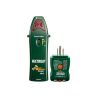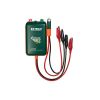Extech Electrical Troubleshooting Kit
Features
- Push button GFCI test
- Continuity testing via bright flashing LED and loud pulsating beeper
- Non-contact detection of AC voltage from 100VAC to 600VAC
- Expedited repair and warranty service
- Lifetime technical support
- More
Overview
The Extech Electrical Troubleshooting Kit includes all the necessary tools to test for electrical applications. The circuit breaker finder quickly locates circuit breakers with an audible and visible alert. The variable sensitivity adjustment is used to pinpoint the correct circuit breaker. Bright red and green LED indicators help users determine if the outlet is correctly wired and identifies six fault conditions.
Mechanics
The continuity tester/wire tracer alerts users via the bright flashing LED and loud pulsating beeper. The remote probe with flashing red or green LED allows users to trace up to three cables. The instrument clips on and hangs from the cable(s) under test without support.
Design
The AC voltage detector/flashlight performs non-contact detection of AC voltage from 100VAC to 600VAC. The instrument is built in a rugged, double-molded housing.
- (1) Circuit breaker finder
- (1) Continuity tester/wire tracer
- (1) AC voltage detector/flashlight
In The News
From Paddles to Phytoplankton: Studying Vermont’s Wildest Lakes
For six months of the year, Rachel Cray, a third-year PhD student at the Vermont Limnology Laboratory at the University of Vermont, lives between a microscope and her laptop, running data. For the other six months, she is hiking and canoeing four of Vermont’s lakes, collecting bi-weekly water samples. Cray studies algal phenology across four lakes in Vermont, US, that have low anthropogenic stress—or in other words, are very remote. Funded by the National Science Foundation Career Award to Dr. Mindy Morales, the lakes Cray researches part of the Vermont Sentinel Lakes Program, which studies 13 lakes in the area and, in turn, feeds into the Regional Monitoring Network, which operates in the Northeast and Midwest US.
Read MoreReimagining Water Filtration: How Monitoring and Science Enhance FloWater Filtration Systems
Over 50% of Americans think their tap water is unsafe , according to the Environmental Working Group (EWG). Other recent surveys have found that number to be as high as 70% of persons surveyed. Whether due to increased public awareness of water quality issues or confusion about how municipal water sources are regulated, there is a clear distrust of tap water in the United States. According to industry expert Rich Razgaitis, CEO and co-founder of the water purification company FloWater, this issue creates a damaging cycle. Razgaitis explained that the health and environmental problems associated with contaminated water aren’t the only issues. As people become increasingly aware that some tap water is unsafe, they resort to bottled water.
Read MoreMonitoring New Hampshire’s Aquatic Ecosystems: Continuous Data Collection in the Lamprey River Watershed
New Hampshire’s aquatic ecosystems provide a range of ecosystem services to the state and region. Resources and services like clean water, carbon storage, climate regulation, nutrient regulation, and opportunities for recreation all depend on New Hampshire’s aquatic ecosystems remaining healthy. Jody Potter, an analytical instrumentation scientist at the University of New Hampshire (UNH), is studying these aquatic ecosystems in hopes of developing an improved understanding of ecosystem services and their interactions with climate change, climate variability, and land use changes. [caption id="attachment_39799" align="alignnone" width="940"] Aquatic sensors in the Merrimack River in Bedford, NH, with I-293 in the background.
Read More








